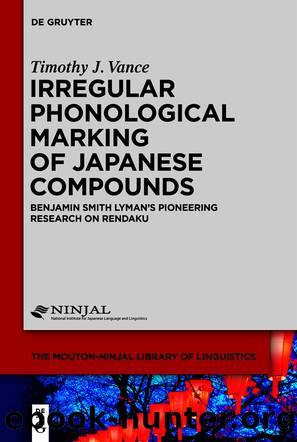Irregular Phonological Marking of Japanese Compounds by Timothy J. Vance

Author:Timothy J. Vance
Language: eng
Format: epub
Publisher: De Gruyter
Published: 2022-04-06T17:48:07.995000+00:00
3[a]
These examples are from the first paragraph of Lymanâs section 3. He did not provide a sub-section label, so I have added â[a]â to make references to this set of examples easier. Lyman described the words listed here as âgiven by Hepburn as compound verbs.â It is clear from the examples that Lyman intended âcompound verbsâ to mean verbs based on two verb elements (i.e., V+V=V compounds). The great majority of such compound verbs do not have rendaku, and Lyman cited only examples that do have it.
Hepburn used the adverbial form (renâyÅkei é£ç¨å½¢) of a verb as its citation form. This same form is sometimes called the infinitive (Bloch 1946:6) or the continuative (Kuno 1973:195) in English. In addition to this citation form, the H2 entry for a verb provides the ending for the conclusive form (shÅ«shikei çµæ¢å½¢), that is, the plain nonpast affirmative, which modern dictionaries use as the citation form. The H2 entry also provides the ending for the plain past affirmative, katakana for the conclusive form, and a transitivity notation (i.v. for an intransitive verb, t.v. for a transitive verb). For example, in the case of ike-doru (modern TÅkyÅ /ike+dorâu/ çãæã âto capture aliveâ), the entry in H2 begins: âIKEDORI, âru, âtta, ã¤ã±ãã«, çæ, t.v.â
Segmentally, the adverbial form (renâyÅkei) is also the form that a verb takes when it is used as (or converted into) a noun, although there is a difference in accent in some cases (Martin 1975:883â885). Since Lyman used this form to cite both verbs and deverbal nouns, many of his examples are ambiguous, as we see especially in his sub-section 4(a) below. Even here in Lymanâs sub-section 3[a], the word that matches his example is in some cases listed in H2 only a noun, not as a verb. I have noted these problematic examples individually. Otherwise, I have just substituted the modern citation form (the conclusive form) without comment.
Normally, the form that the first element takes in a V+V=V compound is also segmentally identical to the adverbial form (renâyÅkei). For example, the first element in /cure+dacâu/ é£ãç«ã¤ âto go togetherâ is /cure/, which is identical both to the adverbial form of the verb /cureâru/ é£ãã âto accompanyâ and to the deverbal noun /cure/ é£ã âcompanionâ. In some cases, however, including a few of Lymanâs examples in this sub-section, the first element appears in a contracted form, as in fun-baru (modern TÅkyÅ /fuN+barâu/ è¸ãå¼µã âto stand firmlyâ). The adverbial form of the verb /fumâu/ è¸ã âto step onâ is /fumâi/ è¸ã¿. I mentioned in the Preface that I use a hyphen to mark what is commonly treated as the boundary between a stem and an inflectional ending, but for verbs in one of the two major traditional conjugation classes, there is no inflectional ending for the adverbial.4 Using the examples already cited in this paragraph to illustrate, the adverbial form of /fumâu/ is /fumâi/, but the adverbial form of /cureâru/ is /cure/, which is identical to the root. This problem comes up in §7.4.2,
Download
This site does not store any files on its server. We only index and link to content provided by other sites. Please contact the content providers to delete copyright contents if any and email us, we'll remove relevant links or contents immediately.
Whiskies (Collins Gem) by dominic roskrow(44965)
Spell It Out by David Crystal(35998)
Cecilia; Or, Memoirs of an Heiress — Volume 1 by Fanny Burney(32384)
Cecilia; Or, Memoirs of an Heiress — Volume 3 by Fanny Burney(31758)
Cecilia; Or, Memoirs of an Heiress — Volume 2 by Fanny Burney(31724)
Beautiful Disaster by McGuire Jamie(25208)
Trainspotting by Irvine Welsh(21461)
Chic & Unique Celebration Cakes by Zoe Clark(19902)
The Secret History by Donna Tartt(18767)
How High Can a Kangaroo Hop? by Jackie French(18744)
Twilight of the Idols With the Antichrist and Ecce Homo by Friedrich Nietzsche(18457)
All the Missing Girls by Megan Miranda(15414)
Cat's cradle by Kurt Vonnegut(15112)
Ready Player One by Cline Ernest(14451)
Fifty Shades Freed by E L James(13129)
For the Love of Europe by Rick Steves(12369)
4 3 2 1: A Novel by Paul Auster(12233)
Crooked Kingdom: Book 2 (Six of Crows) by Bardugo Leigh(12174)
Grundlagen Kreatives Schreiben (German Edition) by Helfferich Pia(10365)
